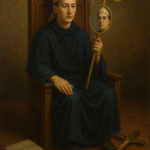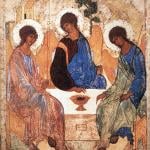London, England, Oct 14, 2016 / 12:02 am (CNA/EWTN News).- Mother Marie Adele Garnier led no ordinary life. Marked with spiritual and physical suffering, visions of Christ, political upheaval, and a dramatically thwarted engagement early in her life, she eventually became the foundress of an order of sisters based in London that has now spread throughout the world. Due to her remarkable life and virtue, Mother Marie Adele Garnier, founder of the Benedictine Tyburn Convent in London, has now been given the title “Servant of God” by the Congregation for the Cause of Saints, the title given to individuals whose cause has officially opened – the first step to canonization. Her sisters have been trying to open her cause for 20 years, but lack of funds prevented them – vow of poverty, and all. “But, in more recent times, on account of the increasing widespread fame of her holiness and her powerful intercession in obtaining both spiritual and temporal favours in response to prayers through her intercession, we firmly believe that the time has come to go forward with her Cause for Canonisation,” the order explains on their website. Mother Garnier was born Marie Adele Garnier on August 15, 1838 in Grancey-le-Château, in the Diocese of Dijon, one of five children. For a long time she felt a desire to be close to Christ, but she did not always know her vocation was to be a nun. At the age of six, Adele’s mother had passed away. Two years later, Adele was sent to boarding school, where she would complete her education at age 16. Shortly after she returned home from school, a young man asked for her hand in marriage, and Marie accepted. But it didn’t last long. According to a recollection of her life by a Benedictine monastery in France, Adele once overheard her fiance joking with a friend that he would “get rid” of Adele’s piety once they were married. Adele couldn’t stand it, and she stormed down the stairs and hurled back: “Sir, you will not have to take the trouble – I will never be your wife!” An argument ensued, and in a dramatic display of despair, the young man plunged a pair of scissors into his chest. It wasn’t a fatal injury, but suffice it to say that the two never married. (Eventually the young man married someone else.) For years after the incident, Adele worked as a beloved governess for a French family at chateau of Aulne. During her time there, she enjoyed serving as the chateau’s sacristan. It was there that a vision of Christ appeared to her on her Host, which would eventually be the image on her order’s medals. Soon after this vision, France was in the throes of the Franco-Prussian War, which resulted in the end of France’s Second Empire. On December 12, 1871, Adele wrote in her diary: “For France: to pray, expiate, suffer, love!” The political upheaval of her country caused Adele great spiritual suffering and desolation, which her spiritual director ordered her to take to Christ in the Blessed Sacrament. After a time of prayer, she was struck “wild with a joy that stripped me of reason, I felt as though struck by lightning, and remained in the grip of a rapture I cannot describe.” Soon after this experience, and after the war had ended, Adele read an article in 1872 of a devout couple planning to build a church in honor of the revelations of the Sacred Heart of Jesus to Saint Margaret Mary. She heard Christ calling her to be at this particular church, and over the next several years she consulted with her spiritual director and with the archbishop to establish perpetual adoration there, which has now been happening nonstop at the Basilica of the Sacred Heart of Montmarte since August 1, 1885. Adele longed to establish a community of sisters devoted to perpetual adoration at Montmarte, but her health and other logistical issues prevented her for several more years. Finally, in March 1897, Adele and two other sisters set up residence in an apartment in Montmartre, dedicating their lives to prayer and apostolate work and wearing white scapulars under their secular clothing. On March 4, 1898, Cardinal Francois-Marie-Benjamin Richard de la Vergne of Paris authorized the establishment of the new order, and the Adorers of the Sacred Heart of Jesus of Montmartre were founded. A few years later though, in 1901, the anti-clerical French government passed the Law of Associations, which greatly expanded the state's authority over religious orders and regulated their educational work. As a result, the sisters went into exile in London, where they were able to freely wear a habit for the first time. They eventually settled at Tyburn, the “mons martyrum” (“mount of martyrs”) in London where in the 16th and 17th centuries, several hundred martyrs – priests, religious, and lay men and women – were executed by the Protestant state for their refusal to give up their Catholic faith. Throughout her life as a religious, Mother Garnier, who now went by Mother Mary of St. Peter, experienced intense physical suffering, so much so that when she went more than two hours without suffering, she wondered if Christ had forgotten her. Despite her sufferings, which included debilitating migraines, her sisters say she remained cheerful and gentle with everyone, and counseled other sisters through their trials. She once told a particularly distraught young sister: “My poor little daughter, I have such pity for you. When you suffer so much, drag your cross on all fours if you must, and then, when things are a little better, try to get up and carry it more valiantly.” The order as a whole also suffered financial problems and strange demonic attacks, including instances of possession or objects being picked up and thrown across the room. But Christ promised Mother Mary of St. Peter that he would not let the order dissolve. According to a report from The Catholic Herald, Fr. Gianmario Piga wrote a spiritual biography of the nun in 2012, in which he relayed the story of Mother Mary’s witnessing of a Eucharistic miracle. In a letter to Fr. Charles Sauvé, Mother recalled how she saw the Blessed Sacrament turn to bloody flesh. “At the moment in which the priest took a particle of the Holy Host and put it into the chalice I raised my eyes to adore and to contemplate the holy particle,” she wrote. “Oh, if you could know what I saw and how I am still moved and impressed by this vision,” she continued. “The fingers of the priest held not a white particle but a particle of striking red, the colour of blood and luminous at the same time … The fingers of the priest were red on the right of the particle, as from a blood stain that seemed still wet.” In 1922, Christ appeared to Mother Mary of St. Peter and told her that she would suffer and die soon. For the next two years, she suffered intense chest pains and congestion problems, until she became bedridden. In spite of her sufferings, she once said: “I believe that I will be cheerful up to the final moment!” She said she offered her sufferings “so that all nations might become Catholic.” On November 15, 1923, on a Host a priest brought her, she saw the Heart of Jesus, alive in the Eucharist. She died June 17, 1924. Today, the contemplative order has spread throughout the world, with convents in England, Scotland, Ireland, Australia, New Zealand, Peru, Ecuador, Colombia, Italy, Nigeria, and France. In 1947, some sisters from Tyburn formed a new congregation, the Benedictines of the Sacred Heart of Montmartre, who serve at the Basilica of Montmartre and other places of pilgrimage in France. The Benedictine Adorers of the Sacred Heart of Jesus of Montmartre remain dedicated to “Eucharistic adoration for the glory of God and prayer for the needs of the whole human family.” The next step in Mother Garnier’s canonization will be for her to be declared Venerable, which means that the Pope recognizes that she led a life of heroic virtue. Read more
















